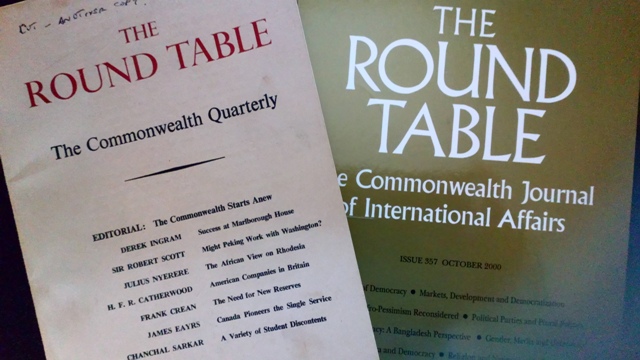
[This is an excerpt from an article currently in our free-to-access series of articles from The Round Table: The Commonwealth Journal of International Affairs. You can read this and other articles for free via the Round Table website.]
Al Qaeda’s Infiltration of the Pakistani Media
According to a Universal Strategy Group Inc. (USGI) report (Citation2011), Al Qaeda’s official communications arm is called ‘As-Sahab’. This outlet specialises in issuing audio, video and text-based statements from senior leaders, including Osama bin Laden, Ayman al-Zawahiri, Abu Yahya al-Libi and Atiyah abd al-Rahman. ‘The Destruction of the American Destroyer USS Cole’, a two-part video released in early 2001, was among the first of As-Sahab’s major productions. Thereafter, the outlet dramatically increased its technical sophistication, thematic diversity and use of post-production special effects. The numbers of productions started to increase steadily after 2000. With approximately seven releases in the first two years, by 2005 the media outlet was producing nearly 200 per year (USGI, Citation2011, pp. 218–219).
Bin Laden was always acutely conscious of how he was portrayed in the media. In 1998, he was known to have made payments to selected Pakistani journalists to increase coverage of his statements and activities (Ciovacco, Citation2009, p. 855). Viewing political communication as very important, Al Qaeda established bases of operations in other countries, allowing the jihadist movement to make headway in achieving its overall goals. For example, after 9/11, in a letter to Mohammad Omar, Osama bin Laden requests interviews from the press, and suggests that this is a good opportunity to make Muslims aware of what is happening in Afghanistan (Corman and Schiefelbein, Citation2006, p. 8). At the same time, part of his communication strategy was to continue releasing televised speeches, broadcast by Al Jazeera and creating global news (Knight, Citation2008, p. 74).
Al Qaeda operatives based in Pakistan were largely non-Pakistani, yet they worked with and through networks of supportive Pakistani militant groups. From sanctuaries in the tribal areas and within key Pakistani cities, Al Qaeda had cultivated links within the various sections of the community (Fair, Citation2011, p. 14). Despite their overwhelming disadvantage in military capabilities compared with the US and its allies, Al Qaeda proved itself a match in psychological warfare and information management. Enjoying considerable appeal in the Arabic and Islamic world, Osama bin Laden influenced the Taliban by his narrative combining geopolitics and deeply held religious beliefs. So while Osama bin Laden was using Al Jazeera to broadcast his messages, the Taliban were effectively using the Pakistani media to put across their point of view (Joshi, Citation2004, pp. 125–126).
Trying to imitate stylistically the Western coverage of the post-9/11 ‘war on terror’, the Pakistani electronic media specifically exploited religion mixed with politics (Sabir, Citation2011, p. 70). An interview with the South Asian Free Media Association (SAFMA) Secretary-General Imtiaz Alam (2010) explains this best:
On the war on terror, the media continued to play a role of duplicity as Musharraf did. Rather it was critical of Musharraf’s co-operation with the west. First of all, the media rejected this war. The media thought that this is America’s war which is imposed on Pakistan and Pakistan does not have any terrorist problem. They defined the terrorists as the national division factors; they even justified their terror tactics … even killing of women children and older people out of their hate for America. Even a big section of media believed that 9/11 was not done by Al Qaeda. They believed in this conspiracy theory that the Jews and the Americans themselves have done 9/11. (Alam, Citation2010)
Even though there was a strong appetite in the market for anti-American stories, the media owners might have been coaxed to provide post-9/11 war coverage that favoured Musharraf. Akhtar (Citation2000) argues that although pressure on the media owners may work because their survival and success depend greatly on the goodwill of the establishment, it fails with journalists. As the working journalist is from the middle class, he or she sometimes feels impelled to deviate from the status quo and to voice the feelings of the general public (Akhtar, Citation2000, p. 95). As many journalists were also explicitly on the Inter Service Intelligence’s (ISI’s) payroll and routinely planted stories to suit the ISI’s interest (Fair, Citation2011, p. 14), it can be argued that some Islamic groups, factions within the ISI and the Taliban shared the same anti-American views that were promoted by a set of inserted journalists. It is commonly accepted in the journalistic community that various journalists in the liberal media houses work for their own interest groups, including mainstream political parties and the unelected Punjabi Islamic right. Therefore, when we consider those reporting the conflict on the ground in the Afghan war it is difficult to determine who was on whose payroll and adhering to whose agenda.
Even though Al Qaeda had probably inserted their journalists into the Pakistani private media, the average Pakistani journalist, who was no plant, demonstrated far more compassion towards the defenceless Taliban who were fighting Allah’s war than towards an unjust, tyrannical superpower. This led pro-Taliban reportage in the news media.
Don’t Mess with Us!
Apart from having a savvy media cell, Al Qaeda had sent a brutal message to the world of journalism through the beheading of the Wall Street Journal’s Daniel Pearl in February 2002. The signal was simple and clear: anybody messing with our business will face serious torture leading to death.
Kiran Hassan is with the Institute of Commonwealth Studies, University of London.



